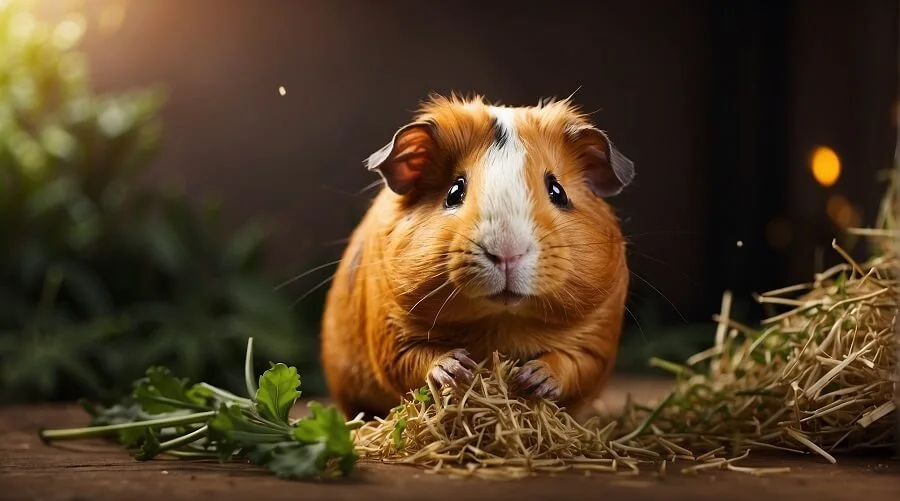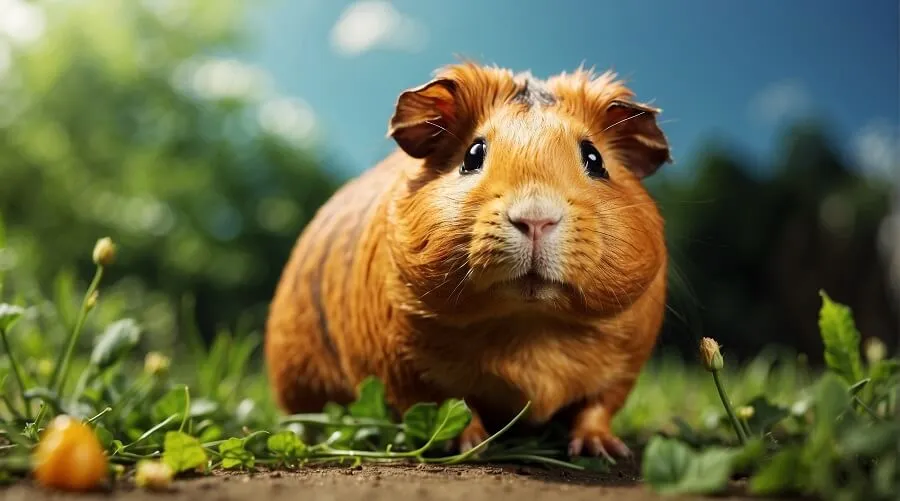Can guinea pigs eat grass from outside? Absolutely! This natural source of nutrition offers a wealth of benefits for their health and well-being. However, like any delicious treat, it comes with a few important safety considerations.
The Benefits of Fresh Grass
Fresh grass is more than just a tasty snack for your furry friend. It’s a nutritional powerhouse packed with essential vitamins, minerals, and fiber.
- Vitamin C: Guinea pigs, like humans, can’t synthesize Vitamin C on their own. Grass provides a healthy dose, crucial for their immune system and overall health.
- Fiber for Digestion:: High-fiber grass keeps their digestive system running smoothly. It prevents constipation and promotes gut health.
- Dental care: Chewing on grass naturally wears down their constantly growing teeth. This prevents overgrown incisors.
- Enrichment and Exercise: Grazing outdoors stimulates their senses, provides exercise, and keeps them mentally engaged.
Related Article: Guinea Pig Care Guide: Must-Knows for New Owners
Precautions if Feeding Fresh Grass
While indulging in fresh grass is a healthy treat, it’s crucial to take precautions:
- Pesticides and Herbicides: Avoid grass treated with chemicals, which can be harmful or even fatal. Opt for untreated areas like parks or nature reserves.
- Toxic Plants: Be aware of poisonous plants in your region. Research safe and unsafe varieties to ensure your guinea pig doesn’t nibble on something harmful.
- Parasites: Grass can harbor parasites. Regular deworming is essential, especially for outdoor grazing.
- Wet Grass: Wet grass can cause skin infections and hypothermia. Wait for dry days before allowing your guinea pig to graze.
- Introduce Slowly: Start with small amounts of fresh grass and gradually increase to avoid digestive upset.
- Supervision is Key. Never leave your guinea pig unattended outdoors. It prevents escapes, encounters with predators, or other dangers.
Related Article: Beyond the Orchard: Can Guinea Pigs Eat Apples?
Tips for Safe Grass Grazing
Now that we’ve explored the benefits and precautions, let’s dive into some practical tips. These will help you have safe and enriching outdoor grazing sessions.
- Cut It Yourself: Instead of using lawn clippings, which can harbor hidden dangers, cut fresh grass yourself with scissors.
- Hay Remains King: While grass offers valuable nutrients, hay should still be the primary source of fiber in your guinea pig’s diet.
- Sunny & Dry Days: Choose dry, sunny days for grazing sessions to avoid wet grass risks.
- Shade and Water: Provide a shaded area and fresh water access outdoors to keep your guinea pig comfortable and hydrated.
- Variety is Key: Offer a mix of safe grass types like Timothy, orchard grass, or brome grass for a more nutrient-rich experience.
- Moderation for Certain Grasses: While tempting, limit wheatgrass and grain-based grasses like barley, oat, and ryegrass due to their higher fat content.
- Alfalfa with Caution: For adult guinea pigs, alfalfa, a legume grass, should be limited or avoided due to its high calcium content.

Indoor Grass Alternatives for Munching
Even when weather or other factors limit outdoor grazing, your guinea pig’s love for fresh greenery doesn’t need to fade. Here are some indoor grass options to keep them munching happily:
- Wheatgrass: Packed with vitamins and minerals. Available as ready-grown trays or DIY with seeds. Start with small amounts to prevent digestive issues.
- Commercial Hay Mixes: Choose high-quality, varied mixes of herbs, grasses, and flowers, with Timothy hay as the base. Promotes natural foraging and adds nutrients. Select reputable brands and avoid dusty types.
- Leafy Greens: Treats like romaine lettuce, endive, and parsley. Introduce slowly in small quantities to prevent digestive problems. Variety is important.
- Sprouts and Microgreens: Nutrient-rich, including broccoli, sunflower, and pea sprouts. Safe for guinea pigs. Grow at home or buy from trusted sources.
- Indoor Gardens: Grow oat grass, ryegrass, or barley indoors organically and pesticide-free. Monitor for nibbling and rotate to avoid soil depletion.
Remember, indoor options should never replace access to fresh air and exercise. When weather permits, continue offering occasional safe outdoor grazing sessions. Follow the previous tips for optimal health and happiness.
You can ensure your guinea pig enjoys the benefits of fresh greenery year-round. By providing a variety of safe and healthy grass alternatives, you can foster a natural diet. This can enrich their indoor experiences.
For more ideas how to feed your guineas pigs visit Diet & Nutrition Page.
Source: Can Guinea Pigs Eat Grass? (Hazards, How Much & More)

